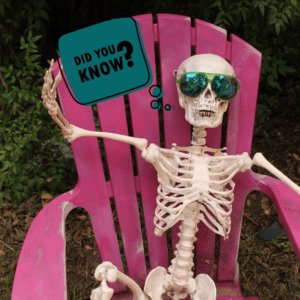October 20th, was World Osteoporosis Day. But what is Osteoporosis?
This week, we want to teach you a little more about this increasingly common condition and explain how we can help 💁♀️ supporting you from diagnosis through to treatment plan.
What is Osteoporosis?
Osteoporosis is a condition that affects the bones 🦴.
It causes bones to weaken, making them more fragile and likely to break.
Inside our bodies, bones are made up of minerals (mainly calcium 🥛) bound together by collagen fibres. We think of bones as being hard and it’s true that on the outside, they have a thick outer shell called cortical or compact bone.
But inside this, there’s a softer, spongier structure. It tends to look a little like honeycomb 🐝.
Our bones are living, active tissue that continue to renew themselves. When we’re children, new bone forms quickly.
The density of our bones is at its peak in our mid to late 20s. But after this, the speed slows down ⏳. From the age of 40, bone is broken down more quickly than it is replaced, such that we lose bone density.
This means that your bones become weak, which means they become more fragile and likely to break 💔.
Who does it affect?
Osteoporosis is quite common in the UK, effecting over 3 million people. As the above suggests, risk increases with age.
Women are four times as likely to get this condition than men 🙆♀️. The reasons for this are that the process of bone loss speeds up after menopause, and that men generally reach a higher level of bone density before the process of bone loss begins.
How is it diagnosed?
Osteoporosis generally develops over many years and is often only diagnosed when there’s a fall or some other sudden impact which causes a bone to break 🤕. This is because we can’t really tell when our bones are weakening!
It’s common for people to experience a broken wrist 🤚, hip 🦵 or vertebrae 🦴 which then reveals Osteoporosis as a factor.
Everyday activities like walking🚶♀️can also become difficult with Osteoporosis.
Before receiving a diagnosis of Osteoporosis, many patients first experience Osteopenia, indicating that you have lower bone density than the average for your age. If you have Osteopenia, you can take steps to keep your bones healthy to reduce the risk of developing Osteoporosis later on.
Risk factors that can contribute to developing Osteoporosis include:
– Taking steroids 💊. These drugs can affect the production of bone, reducing calcium absorption in the body and increasing calcium loss in the kidneys.
– Not doing enough weight-bearing exercises 🏋️♀️. Exercise encourages your bones to develop, and a lack of exercise can mean you’re more likely to be losing calcium from your bones. Muscle and bone health are related, so keep up that muscle strength!
– Low oestrogen levels 💁♀️. If you are a woman and have early menopause (before 45 years of age) or have a hysterectomy, this can increase the risk of developing osteoporosis. This is due to the dramatic reduction of oestrogen production when either early menopause or a hysterectomy occurs in the body.
– Poor diet habits 🥗. Make sure you’re getting enough calcium and Vitamin D in your diet, and that you’re a healthy weight – being underweight can also pose a greater risk.
– Poor lifestyle habits 🍻. If you drink a lot of alcohol, this can reduce your body’s ability to produce bone. Smoking is also bad for bones, lowering both oestrogen and testosterone activity in the body which can weaken bones.
– Family history 👨👩👧👦. Osteoporosis can run in the family. Be aware of this as a risk factor if a close relative has had an Osteoporosis diagnosis.
Receiving a diagnosis can be scary, but don’t lose hope! It is possible to slow or reverse the effects of Osteoporosis, even after a diagnosis.
How can it be treated?
If you’ve come on a diagnosis because of a fracture, the fracture has to be treated first 🩹.
Once you’re well enough, treatment plans can include exercise, which can help build bone density 💪 – in particular, using Wolff’s Law.
Wolff’s Law says that your bones adapt according to the stress or demands placed on them. So, when you work your muscles 🙆♂️, this puts a kind of stress on your bones, and in response, your bones strengthen.
However, the opposite is also true. If you don’t use your muscles, the bone tissue can also weaken 🤕!
You have to start slow and seek out advice from us 💁♀️. We can advise about the timeline of what you can do and when, as your body heals. This is important to do in a careful and controlled way, so that you don’t risk injuring yourself again.
While chiropractic adjustments cannot cure Osteoporosis, we can definitely work with you to offer you support and advice 💪.
This includes providing stretches and exercises that will help with mobility and strengthen the muscles and tissues surrounding your bones to stabilise them and prevent future injuries.
We can also take a look at your lifestyle and help suggest ways to make changes that support building up your bone mass.
Unfortunately, Osteoporosis is a chronic and progressive condition. Without treatment and monitoring, it can worsen over time, especially as we get older.
Ask us for more information and we can help monitor and support your treatment plan, setting in place the right things that you need so that you can maintain a happy and healthy lifestyle for as long as possible!






1 thought on “Osteoporosis: A bone of contention?”
Thank you, this article gave a really clear and helpful explanation of what osteoporosis is and how to prevent and treat it.